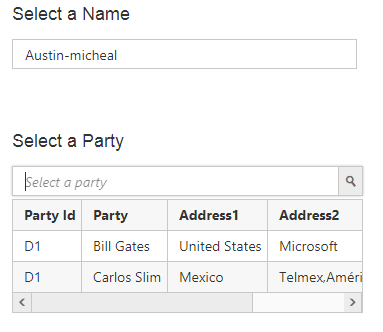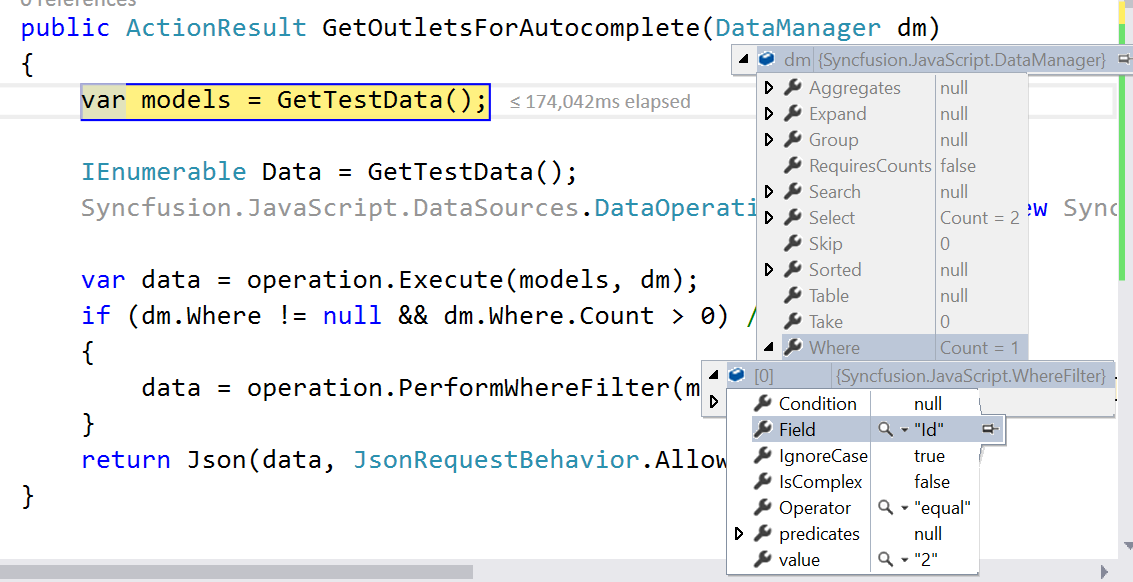How To
12 Jun 202324 minutes to read
Pass the selected items key value to code behind directly
The selected item key value of Autocomplete can be passed to server side by mapping the control ID as the mapping. Here, the selectData is set as ID of the autocomplete and through which the selected value can be manipulated in server side post.
@using (Html.BeginForm("AutocompleteFeatures", "Autocomplete"))
{
<ej-autocomplete id="selectData" filter-type="Contains" show-popup-button="true" enable-auto-fill="true" width="50%" watermark-text="Select value">
<e-datamanager url="DataSource" adaptor="UrlAdaptor"></e-datamanager>
<e-autocomplete-fields text="Title" key="Id" />
</ej-autocomplete>
<input class="button" id="submit" type="submit" value="Submit" />
}[HttpPost]
public ActionResult AutocompleteFeatures(string selectData)
{
//do something here
}Add a new value to Autocomplete
You can add the newly typed value to the AutoComplete where us the newly typed value is not available in already existing data source. This can be achieved by setting property allowAddNew with multiSelectMode set as visualMode. The typed new value can be added by clicking the Add New shown in the suggestion list and this can be visually added to AutoComplete.To update the data source with the new value, you can process this select event.
<script>
function onSelect(args) {
if (args.text.indexOf('Add New') >= 0) {
//separate the value
var value = args.text.replace('(Add new)', '');
//push the value to datasource
this.model.dataSource.push({ text: value.trim()});
this._doneRemaining();
this.option("value", value.trim())
}
}
</script>The following screenshot exhibits the output before the solution. Click the Add New text shown to add this value to auto complete.

The following screenshot exhibits the output of the above code.

URL,Web API adaptor server side filtering
When the dataSource of AutoComplete bound with Adaptors such as WebAPI/URL, then we need to perform the filtering and sorting operation in server side using LINQ or our DataManager API operations before returning data to the client side.
This change is applicable for all operations that needs to fetch altered data from Data source like filter, search etc.
The below code snippet will perform the sorting/filtering in server side before the data is passed to the Autocomplete.
public ActionResult UrlDataSource([FromBody]DataManager dm)
{
IEnumerable DataSource = OrderRepository.GetAllRecords();
DataOperations ds = new DataOperations();
List<string> str = new List<string>();
if (dm.Search != null && dm.Search.Count > 0)
{
DataSource = ds.PerformSearching(DataSource, dm.Search);
}
//Filtering
if (dm.Where != null && dm.Where.Count > 0)
{
DataSource = ds.PerformWhereFilter(DataSource, dm.Where, dm.Where[0].Operator);
}
//Sorting
if (dm.Sorted != null && dm.Sorted.Count > 0)
{
DataSource = ds.PerformSorting(DataSource, dm.Sorted);
// return the sorted value of Autocomplete from here
if(dm.Where[0].Operator == "startswith")
return Json(DataSource);
}
var count = DataSource.Cast<EditableOrder>().Count();
DataSource = ds.PerformSkip(DataSource, dm.Skip);
DataSource = ds.PerformTake(DataSource, dm.Take);
return Json(new { result = DataSource, count = count });
}Cascade between two Autocomplete
By default, we did not have in-built cascading support in Autocomplete. But, we can able to achieve this by using client-side events change and select. Refer to the below steps.
1.Based on the typed letter in the Autocomplete, perform the AJAX Post with the typed letter as filtering key words through the change event in Autocomplete1 component.
2.Upon selecting the value in Autocomplete1, the select event is triggered. Process the selected value which got in event and fetch the data from Data source.
3.Bind the newly fetched filtered data to the Autocomplete2 component.
<script>
function onChange(args) {
$.ajax({
url: "/Autocomplete/Suggestions",
data: { search: args.value },
type: 'POST',
dataType: "json",
success: function (response) {
var ac = $("#search1").ejAutocomplete("instance");
if (response != null && response.length) {
ac.suggestionListItems = response;
ac._doneRemaining();
} else
ac._hideResult();
}
});
}
function onSelect(args) {
$.ajax({
url: "/Autocomplete/NewSuggestions",
data: { id: args.key },
dataType: "json",
success: function (result) {
var data = eval(result);
var obj = $('#search2').data("ejAutocomplete");
obj.setModel({
dataSource: data, enabled: true, watermarkText: "Select a party",
});
}
});
}
</script>public JsonResult Suggestions(string search)
{
if (search == "")
{
return null;
}
else
{
var Data = setListSource();
//filter data based on the search string value
var search = from n in Data where n.text.ToLower().StartsWith(search.ToLower()) select n;
return Json(search, JsonRequestBehavior.AllowGet);
}
}
public JsonResult NewSuggestions(string id)
{
var Data = set_partySource();
//filter data based on the selected key value
var search1 = from n in Data where n.No.Contains(id) select n;
return Json(search1, JsonRequestBehavior.AllowGet);
}The following screenshots exhibits the output of the above code.

Expected output after cascading
Strongly Typed HTML Helper
The Autocomplete control supports strongly typed HTML helpers which uses lambda expression to refer models or view models passed to a view template. These helpers allow you to define the value of the AutocompleteFor from the model. The following steps explain how to use the strongly typed helpers to create AutocompleteFor.
Add a class named "AutocompleteModel" in the Models folder and replace the code with the following code.
public class AutocompleteModel
{
[Display(Name = "Auto Data")]
public List<AutocompleteValue> AutoData { get; set; }
}
public class AutocompleteValue
{
public string Text { get; set; }
public string Value { get; set; }
}In the controller, pass the model to the View.
using CoreApplication.Models;
using Syncfusion.JavaScript.Models;
namespace CoreApplication.Controllers
{
public class HomeController : Controller
{
public IActionResult Index()
{
AutocompleteModel model = new AutocompleteModel();
return View(model);
}
}
}Then in the View invoke the strongly typed AutocompleteFor helper with the ej-for tag helper.
@model CoreApplication.Models.AutocompleteModel
<ej-autocomplete id="Autocomplete" ej-for="@Model.AutoData" datasource="ViewBag.datasource" filter-type="Contains" show-popup-button="true" enable-auto-fill="true" width="50%" watermark-text="Select value">
<e-autocomplete-fields text="Text" key="Value" />
</ej-autocomplete>How to set autocomplete default value
You can set a value into autocomplete at initial rendering using value property. It is used to select a single value from the autocomplete widget at initial rendering state.
Refer to the following code.
<ej-autocomplete id="selectState" datasource="ViewBag.datasource" value="Arizona">
<e-autocomplete-fields text="countryName" key="index" />
</ej-autocomplete>public partial class AutocompleteController : Controller{
List<states> state = new List<states>();
public ActionResult AutocompleteFeatures()
{
state.Add(new states { index = "s1", countryName = "Alabama" });
state.Add(new states { index = "s2", countryName = "Alaska" });
state.Add(new states { index = "s3", countryName = "Arizona" });
ViewBag.datasource = state;
return View();
}
}
public class states
{
public string index { get; set; }
public string countryName { get; set; }
}The following output is displayed as a result of the previous code example.

If you set autocomplete value property as a string that is present in the data source, the hidden input value holds the corresponding key value. This is used for validation purpose in the autocomplete. For example, Arizona text holds the key value of s3. The autocomplete default value Arizona is present in the countryName of data source and also this field is mapped for autocomplete text property. So, hidden input value holds the s3 value.
The following screenshot illustrates the previous hidden input state of code.

If you set autocomplete value property as a string that is not present in the data source, the hidden input value holds the autocomplete value. For example, if autocomplete default value is New York and not present in the countryName of data source, the hidden input value holds the New York string.
Refer to the following code sample.
<ej-autocomplete id="selectState" datasource="ViewBag.datasource" value="New York">
<e-autocomplete-fields text="countryName" key="index" />
</ej-autocomplete>The following screenshot illustrates the previous hidden input state of code.

Remote data
The remote data also allows you to set the default value into autocomplete using value property.
Refer to the following code sample.
<ej-autocomplete id="selectState" value="Two">
<e-datamanager url="/Home/GetOutletsForAutocomplete" adaptor="UrlAdaptor"></e-datamanager>
<e-autocomplete-fields text="Name" key="Id" />
</ej-autocomplete>public JsonResult GetOutletsForAutocomplete([FromBody]DataManager value)
{
var models = GetTestData();
IEnumerable Data = GetTestData();
Syncfusion.JavaScript.DataSources.DataOperations operation = new Syncfusion.JavaScript.DataSources.DataOperations();
if (value.Where != null && value.Where.Count > 0) //Filtering
{
Data = operation.PerformWhereFilter(models, value.Where, value.Where[0].Operator);
}
return Json(Data);
}
public class AutocompleteModel
{
[Display(Name = "Id")]
public string Id { get; set; }
[Display(Name = "Name")]
public string Name { get; set; }
}
private List<AutocompleteModel> GetTestData()
{
var list = new List<AutocompleteModel>();
list.Add(new AutocompleteModel(){ Id = "1", Name = "One"});
list.Add(new AutocompleteModel(){ Id = "2", Name = "Two"});
list.Add(new AutocompleteModel(){ Id = "3", Name = "Three"});
return list;
}The autocomplete value property triggers a server-side post when using remote data in the autocomplete. The server side data manger holds where query which contains field name as autocomplete text property.
Find the following screenshot for the data manager where query.

Find the following output for the previous code.

How to show text on autocomplete using key value
You can set the value of autocomplete text box based on a given key value. The select-value-by-key property is used to select autocomplete value based on the specified key value.
Refer to the following code sample.
<ej-autocomplete id="selectState" datasource="ViewBag.datasource" select-value-by-key="s2">
<e-autocomplete-fields text="countryName" key="index" />
</ej-autocomplete>public partial class AutocompleteController : Controller{
List<states> state = new List<states>();
public ActionResult AutocompleteFeatures()
{
state.Add(new states { index = "s1", countryName = "Alabama" });
state.Add(new states { index = "s2", countryName = "Alaska" });
state.Add(new states { index = "s3", countryName = "Arizona" });
ViewBag.datasource = state;
return View();
}
}
public class states
{
public string index { get; set; }
public string countryName { get; set; }
}For example, If select-value-by-key property specified the value as ‘s2’, the corresponding text value Alaska is shown in the autocomplete text.
The following output is displayed as a result of the previous code example.

If you are specifying the select-value-by-key property into autocomplete control, the hidden input value holds a specified key value.
Refer to the following screenshot.

Remote data
The remote data also allows you to set the default value into autocomplete based on a given key value using the select-value-by-key property.
Refer to the following code snippet.
<ej-autocomplete id="selectState" select-value-by-key="2">
<e-datamanager url="/Home/GetOutletsForAutocomplete" adaptor="UrlAdaptor"></e-datamanager>
<e-autocomplete-fields text="Name" key="Id" />
</ej-autocomplete>public JsonResult GetOutletsForAutocomplete([FromBody]DataManager value)
{
var models = GetTestData();
IEnumerable Data = GetTestData();
Syncfusion.JavaScript.DataSources.DataOperations operation = new Syncfusion.JavaScript.DataSources.DataOperations();
if (value.Where != null && value.Where.Count > 0) //Filtering
{
Data = operation.PerformWhereFilter(models, value.Where, value.Where[0].Operator);
}
return Json(Data);
}
public class AutocompleteModel
{
[Display(Name = "Id")]
public string Id { get; set; }
[Display(Name = "Name")]
public string Name { get; set; }
}
private List<AutocompleteModel> GetTestData()
{
var list = new List<AutocompleteModel>();
list.Add(new AutocompleteModel(){ Id = "1", Name = "One"});
list.Add(new AutocompleteModel(){ Id = "2", Name = "Two"});
list.Add(new AutocompleteModel(){ Id = "3", Name = "Three"});
return list;
}The autocomplete select-value-by-key property triggers a server-side post when using remote data on autocomplete. The server side data manger holds where query which contains field name as autocomplete key property.
Find the following screenshot for the data manager where query.

Find the output for the previously given code as follows.
